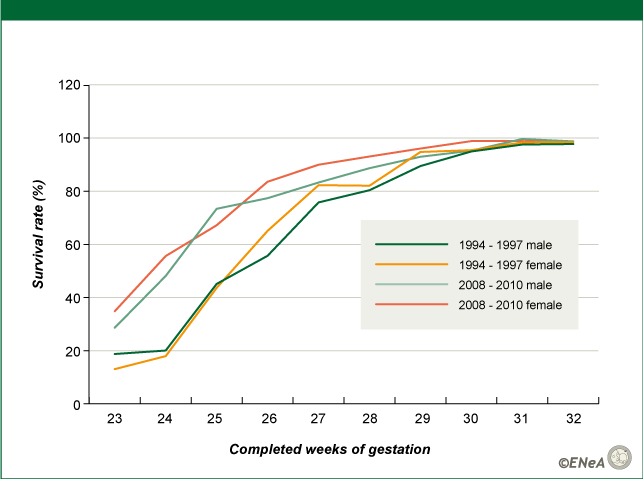Lesson 1: Preterm Birth: A Global Public Health Issue
1.2 Preterm infant survival and mortality
The chance that a preterm infant will survive increases with longer length of gestation and higher birthweight. Medical advances, such as newer respiratory support techniques, antenatal administration of corticosteroids to the mother in cases of threatened preterm birth, postnatal tracheal administration of surfactant to the infant, and improvements in nutrition of the preterm infant, have contributed to improved chances of survival at ever-lower birthweights and gestational ages.
Figure 2a: Decreasing mortality rates among preterm infants 1960-2006 by birthweight.
Source: Singh & van Dyck 2010
Figure 2b: Decreasing mortality rates among preterm infants 1960-2006 by gestational age
Source: Singh & van Dyck 2010
Manktelow analyzed in 2013 data from a cohort of 2995 white singleton, very preterm infants in England, to update earlier charts used in counseling parents of preterm infants on the chances of survival. These data illustrate the general increase in survival of preterm infants at higher gestational ages, as well as improvements over time in survival rates at earlier gestational ages (Manktelow et al. 2013). Data from a study of 9575 extremely preterm infants (gestational age 22-28 weeks) conducted by the Eunice Kennedy Shriver National Institute of Child Health and Human Development Neonatal Research Network between 2003-2007 show similar survival rates (Stoll et al. 2010).
Figure 3: Survival rates of very preterm infants by completed week of gestation in two English cohorts: 1994-1997 and 2008-2010
Source: ENeA own graph. Data from Manktelow et al. 2013.
Great disparities exist, however, in survival rates of preterm infants in different regions of the world. In developing countries, over 90% of infants who are born before 28 weeks of gestation will die. Whereas, in high income countries over 90% of these infants will survive (WHO et al. 2012).



